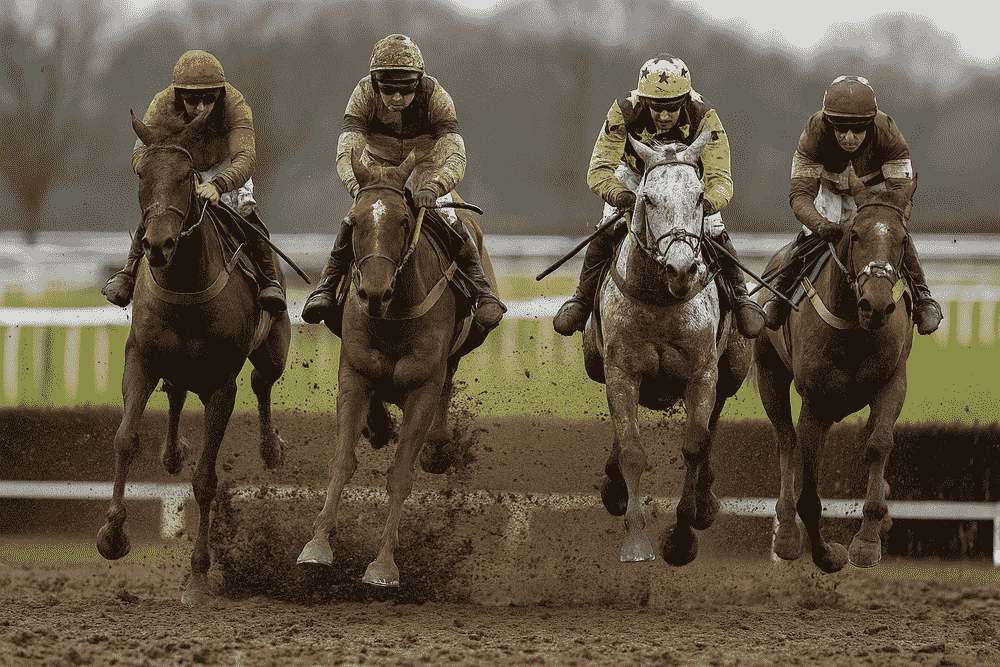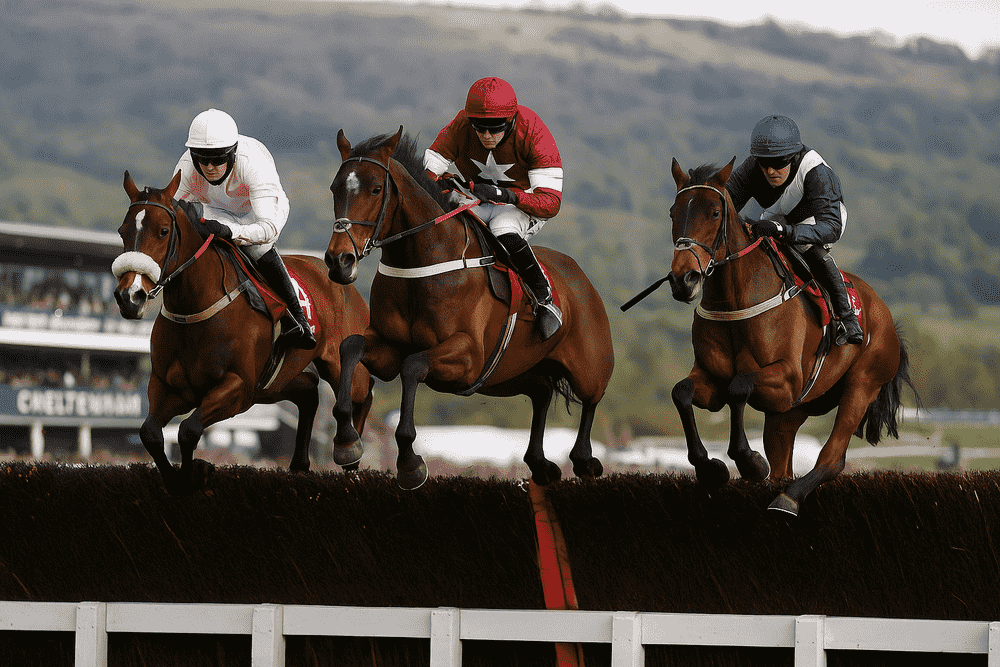When the rain starts falling and the ground turns testing, some horses simply come alive. This guide introduces ten soft ground specialists National Hunt fans should follow through the 2025/26 jumps season — the true mud lovers that thrive when the going turns heavy.
If you haven’t yet read our full Horses to Follow for the 2025/26 Jumps Season, it’s the perfect companion to this piece — packed with profiles, trends and early-season standouts worth tracking.
When the mud season — and the soft-ground specialists — truly begin
When October turns into November, the jump racing calendar finally feels alive again. The nights draw in, the air smells of damp grass and coffee in paper cups, and trainers start talking about “proper winter ground.” It’s the time of year when the turf thickens, boots get heavier, and the true mud lovers begin to grin.
For a full overview of what’s coming up, check out our National Hunt 2025/26 calendar — it lists every key meeting across Britain and Ireland so you can plan your winter weekends ahead.
Ask any racegoer at Chepstow or Navan — this is the season they wait for. You can almost hear the sigh of relief from the old-school fans when the word “soft” appears in the going report. It means the flashy summer types have gone home and the grinders, stayers and relentless sloggers take centre stage — the real mud lovers of National Hunt racing.
Britain and Ireland’s love affair with soft-ground racing
The British and Irish jumps scene has a special love affair with mud, and nowhere else produces as many true soft-ground specialists. From the Welsh National at Chepstow, run through sheets of rain, to the deep tests of Haydock’s Betfair Chase, soft or heavy ground often rewrites the form book. That’s why punters who pay attention to ground specialists usually get rewarded while others scratch their heads at 20/1 winners — it’s part of what defines every National Hunt season.
Historically, some of the most beloved horses were downright bog beasts. Think of Red Rum powering through soaked Aintree fences in the 1970s, Bristol De Mai turning Haydock into his personal swamp, or Native River grinding rivals into submission in the 2018 Gold Cup. These weren’t flukes — they were the results of horsepower built for bad weather.
So before you grab your scarf and head to the next meeting, keep one thing in mind: when the rest of Britain and Ireland are moaning about rain, National Hunt racing is only just warming up. And for some horses, the wetter it gets, the better they become. That’s why every year, British and Irish fans build their trackers around proven soft ground specialists National Hunt horses who make the long winter weekends worth every muddy minute.

Why soft (or heavy) ground defines true soft ground specialists National Hunt fans love
If you’ve ever trudged across Haydock’s car park in December, you already know: winter jump racing is a different sport — and the stage where soft-ground specialists of the National Hunt truly shine.
Soft or heavy ground slows everything down, tests stamina to the limit, and rewards a certain type of horse — big engine, high-knee action, and a mindset that says “the deeper the better.”
It also changes track dynamics. Chepstow and Haydock become brutal stamina tests, while Kempton on good-ish ground still suits speedier types. Form on soft ground isn’t a bonus — it’s a weapon. When others are floundering, the true mud lovers just keep finding more — proof that soft-ground horses often rule winter racing.
10 soft ground specialists National Hunt fans should follow this season
Below you’ll find ten proven soft-ground specialists who come alive once the rain sets in. From Haydock bog beasts to Irish stayers, these are the National Hunt mud lovers worth tracking through the 2025/26 season.
| 🏇 Horse | Best muddy track | Key win (Soft/Heavy) | Typical trip |
|---|---|---|---|
| Royale Pagaille | Haydock | Betfair Chase (2024) | 3m1f–3m2f |
| Teahupoo | Cheltenham / Punchestown | Stayers’ Hurdle (2024) | 2m7f–3m |
| Grey Dawning | Cheltenham | Brown Advisory Novices’ Chase (2024) | 3m |
| Crambo | Ascot | Long Walk Hurdle (2023 & 2024) | 3m |
| Lossiemouth | Cheltenham | Mares’ Hurdle (2025) | 2m4f |
| I Am Maximus | Aintree | Grand National (2024) | 4m2½f |
| Vanillier | Aintree / Leopardstown | 2nd Grand National (2024) | 3m4f–4m |
| Gaillard Du Mesnil | Punchestown / Cheltenham | National Hunt Chase (prev.) | 3m6f+ |
| Hiddenvalley Lake | Aintree | Liverpool Hurdle (2024) | 3m |
| Meetingofthewaters | Cheltenham | Ultima Handicap Chase (2024) | 3m1f |
Whether they’re proven Grade 1 winners or emerging stayers, each of these soft-ground horses has one thing in common — they make National Hunt racing in winter worth watching.
You can discover even more profiles like these in our Horses to Follow category — regularly updated with jumpers to keep onside throughout the 2025/26 season.
Royale Pagaille – the Haydock heavyweight
If there’s a swamp to slog through, Royale Pagaille wants to be in it.
He’s a three-time Betfair Chase winner (latest in 2024), every victory achieved on soft or heavy ground at Haydock.
It’s his playground. His relentless gallop and staying power make him near unbeatable there when the going turns deep.
Few soft-ground chasers in Britain have shown such reliability at Haydock as Royale Pagaille, a true mud-season powerhouse whose best days always come when others are gasping for breath.
Tip: When you see “Haydock – soft,” don’t overthink it.
Why he thrives in it
Royale Pagaille is built like a small tank — deep-chested, powerful behind, and happiest when rhythm replaces speed. Heavy ground doesn’t slow him down as much as it does others; it simply lets his stamina take over. His wide, balanced frame allows him to stay upright through churned-up surfaces where lighter types flounder. When others shorten their stride, he’s still rolling through the sludge with his ears pricked.
What to watch this season
Trainer Venetia Williams tends to start him fresh in the late-autumn mud at Haydock before targeting the Gold Cup route. Expect another crack at the Betfair Chase or Peter Marsh Chase, both run on testing ground, followed by possible spring targets if the weather stays wet. Don’t be surprised if connections finally send him back to Cheltenham in March should the word “soft” appear in the description.

Teahupoo – Ireland’s mud-loving Stayers’ king
The Stayers’ Hurdle (Cheltenham 2024) and Punchestown Stayers’ Hurdle both fell to Teahupoo — the first to do that double since 1999.
Those races were proper stamina tests on soft to heavy going, and he made them look like routine workouts.
He’s still improving and remains Gordon Elliott’s standard-bearer for when the heavens open.
Tip: If it’s wet, he’s almost automatic in staying hurdles.
Why he thrives in it
Teahupoo’s action screams soft-ground specialist. He lifts his knees higher than most hurdlers, digs deep into the turf and keeps an unrelenting rhythm when conditions turn sticky. On testing going, his rivals’ finishing kicks vanish while he just keeps finding. It’s not coincidence that his highest Racing Post Ratings have all come in rain-soaked Grade 1s — he simply enjoys a slower tempo and longer grind.
That makes him one of Ireland’s most proven soft-ground hurdlers, and a banker to follow whenever winter rain turns the tracks heavy.
What to watch this season
Gordon Elliott has hinted that Teahupoo will defend his Stayers’ Hurdle crown before perhaps travelling to France for the Grand Course de Haies d’Auteuil, a race often decided in deep ground. With the Irish winter forecast predicting a wetter spell, he could dominate the staying division once again. Bettors take note: if the word “yielding-to-soft” appears in any Irish card, he’s as close to bomb-proof as they come.
Grey Dawning – the honest grinder with endless fuel
This likeable grey announced himself with a strong win in the Brown Advisory Novices’ Chase (Cheltenham 2024), run on Soft, heavy in places.
He’s all heart, jumps well in testing ground, and has the stamina to turn any staying chase into his comfort zone.
Tip: At stiff tracks like Cheltenham or Warwick, his toughness becomes a huge asset.
Why he thrives in it
Grey Dawning doesn’t need a quick surface; he prefers a rhythm race where his relentless engine can stretch the field. He plants each stride with purpose, barely losing efficiency when the going turns gluey. His scopey jumping style actually helps on slower ground, giving him time to measure fences without rushing. At Cheltenham, when others tire after the last, he keeps grinding to the line — the mark of a natural stayer.
What to watch this season
Trainer Dan Skelton is plotting a Gold Cup campaign, but don’t rule out intermediate stops like the Cotswold Chase or Savills Chase if conditions stay soft. Expect him to peak mid-season, around December to February, when the going reads “soft or heavy.” He’s the type you can trust to hit the frame even when the favourites are floundering.

Crambo – Ascot’s winter warrior
Crambo’s Long Walk Hurdle wins (2023 and 2024) proved two things: he stays forever, and he thrives in proper winter ground.
He may not have the flashiest turn of foot, but when it’s sticky, deep and miserable, he’s relentless.
Tip: If Ascot looks like a bog, Crambo’s one to side with.
Why he thrives in it
Crambo is the definition of a winter hurdler. His long stride and low, driving action allow him to plough through tiring ground without losing rhythm. He’s also incredibly genuine — a horse who digs deep when others start flapping. Ascot’s stiff finish suits that determination perfectly; every Long Walk Hurdle he’s contested has turned into a stamina examination, and he’s usually the one still galloping when the cameras pan past the post.
What to watch this season
Trainer Fergal O’Brien has indicated another tilt at the Long Walk before targeting the Stayers’ Hurdle at Cheltenham. If the weather stays wet, his grinding style could expose speedier rivals. Punters should keep an eye on any early entries at Lingfield’s Winter Million meeting, where heavy ground often levels the playing field in his favour.
Lossiemouth – classy but comfortable in the slop
It’s rare for a speedy mare to handle bad ground, but Lossiemouth isn’t ordinary.
She’s proved she can handle soft conditions, confirmed when she won the Mares’ Hurdle at Cheltenham 2025, a Festival staged on soft, testing ground.
Tip: Don’t assume class horses hate the mud — she’s living proof they can glide through it.
Why she thrives in it
Lossiemouth may look elegant, but there’s steel beneath that polish. Her high knee action means she gets real grip in softer conditions, and her balance — rare for a mare of her size — keeps her light on her feet even when it’s tacky underfoot. In races run at Cheltenham or Fairyhouse on soft ground, she travels strongly while rivals flounder. Her engine isn’t just big; it’s efficient.
What to watch this season
Willie Mullins has plenty of options for her: another Mares’ Hurdle defence, a possible step into open Grade 1 company, or even a French raid if Auteuil’s spring ground turns deep. Whatever route she takes, she’s a banker to handle testing conditions. If the Festival forecast reads “soft,” expect her to shorten fast in the market.
I Am Maximus – Grand National hero in the sludge
Winning the Grand National (Aintree 2024) on soft ground tells you all you need to know.
He stayed every inch of the trip, jumped with precision, and looked fresher than his rivals after four miles.
He’s still lightly raced for a staying chaser — scary thought if it’s soft again next spring.
Tip: Whenever stamina is tested and the sky’s grey, keep him on your list.
Why he thrives in it
I Am Maximus isn’t flashy — he’s functional, and that’s exactly what the Grand National demanded in 2024. His jumping rhythm improves when the pace slackens, and on soft ground he can sit handy without being rushed. The deeper it gets, the more it becomes about heart and stamina, and he’s got both in spades. His rangy frame helps him float over holding turf where smaller chasers sink.
What to watch this season
Expect trainer Willie Mullins to give him a prep in Ireland, possibly the Bobbyjo Chase or the Savills Chase, before returning to Aintree. He could also appear in the Irish Grand National if the ground suits. The goal will be to keep him fresh for another tilt at history — and if it’s raining, confidence will rise with the puddles.

Vanillier – the relentless finisher
Chasing home I Am Maximus in the 2024 National, Vanillier again showed his soft-ground stamina.
He lacks a flashy turn of foot but possesses bottomless reserves of energy — the kind that counts when others fade.
Tip: Ideal each-way play in any slog from Leopardstown to Aintree.
Why he thrives in it
Vanillier is bred for this. By Martaline, from a staying French line, he naturally handles cut in the ground. His long, loping stride eats up the final furlong when others shorten. Crucially, he keeps his head down and stays straight through tired conditions — a rare quality when fences look twice their normal size in a slog. In every major chase he’s contested on soft or heavy, his late surge has been his trademark weapon.
What to watch this season
Gavin Cromwell plans another campaign built around stamina-rich tests like the Thyestes Chase or Irish Grand National. Expect him to appear in deep mid-winter handicaps before Aintree. If Liverpool’s forecast calls for showers, he’ll be one of the first names on punters’ lists.
He’s become something of a cult hero among mud-loving National Hunt followers, always finding another gear when the ground turns deep.
Gaillard Du Mesnil – stamina machine
Few horses stay like this Willie Mullins gelding.
He’s proven on soft, consistent across the toughest staying chases, and mentally rock-solid.
Expect him to pop up again this winter whenever ground turns sticky.
Tip: Punchestown or Cheltenham in deep winter? Add him to your shortlist.
Why he thrives in it
Few chasers absorb pressure like Gaillard Du Mesnil. He’s rhythmical, clever at his fences, and settles beautifully — traits that matter even more when the surface is testing. His heavy-ground win in the National Hunt Chase (Cheltenham 2023) proved he can outstay practically anything over marathon trips. On soft ground, his relentless gallop grinds opposition into submission rather than needing a turn of foot.
What to watch this season
Willie Mullins might mix it up: the Cross-Country route has been mentioned, but he could also re-emerge for the Punchestown Gold Cup or the Grand Steeple de Paris if the spring stays wet. Any race labelled “3m6f+” instantly puts him among the favourites once the rain arrives.
Hiddenvalley Lake – young, strong, and ready for mud
Labelled early as a soft-ground type, Hiddenvalley Lake confirmed the hype with victory in the Liverpool Hurdle (Aintree 2024).
Henry de Bromhead’s gelding gallops through deep conditions, yet handled better going too — a great sign for versatility.
Tip: When rain’s falling and the trip is around 3 miles, expect a big run.
Why he thrives in it
Hiddenvalley Lake has the physicality you dream of in a soft-ground stayer: big barrel, powerful hindquarters and the sort of deep lung capacity that shrugs off gluey going. His Albert Bartlett second on soft confirmed he’s happiest when races become grinds. He’s also responsive — the kind that listens to his jockey rather than fighting the reins, conserving energy when it counts.
What to watch this season
Henry de Bromhead will likely aim him at the Long Distance Hurdle or early-season Irish Grade 2s before another Festival attempt. He’s still unexposed and improving with every run. If the winter turns properly wet, expect whispers of him switching to fences — his frame suggests he’ll love it.

Meetingofthewaters – emerging mud merchant
His big moment came in the Ultima Handicap Chase (Cheltenham 2024), staged on heavy, soft in places.
He stayed on powerfully through gluey ground to hit the frame and looks a natural for similar conditions this season.
Tip: Perfect type for deep-ground handicaps up to 3 m 1 f.
Why he thrives in it
Meetingofthewaters has already shown he relishes attritional handicaps. His Ultima effort proved he travels comfortably in the sludge and keeps finding when pace collapses. He’s balanced, economical over fences, and doesn’t over-race — vital traits for longevity in soft ground. The deeper it gets, the more rivals he reels in.
In fact, his smooth jumping and stamina make him a genuine soft-ground specialist, the sort who improves as the going worsens.
What to watch this season
Expect him to target big-field staying handicaps such as the Ladbrokes Trophy (Newbury) or a return to Cheltenham’s December Meeting. Trainer Willie Mullins likes to give him space between runs, so don’t panic if he skips November. Any headline containing “soft” or “testing” means he’s dangerous again.
How to spot a mud lover
Spotting a future soft-ground specialist isn’t as tricky as it sounds — you just need to know what signs to look for before the rest of the market catches on.
Want to find the next one before the market does? Look for these clues:
- Form lines showing wins or top runs on Soft or Heavy.
- Rounded knee action when you watch the replay — daisy-cutters rarely enjoy it.
- Pedigree clues: names like Yeats, Milan, Kayf Tara, or Sholokhov often scream stamina.
- Track record: Haydock, Chepstow, Navan and Carlisle often expose who can truly slog.
- Attitude: horses that finish their races even when tired are worth following in deeper tests.
(UK “going” scale reminder: Good → Good-to-Soft → Soft → Heavy; in Ireland you’ll see “yielding” around the middle).
These traits are what separate true National Hunt mud lovers from fair-weather types — spot them early, and you’ll stay ahead when the heavens open.
Betting angles when the rain keeps falling: how to profit from soft-ground horses
When the rain turns the track into glue, betting on jump racing becomes a different game entirely. Soft or heavy ground races reward patience, stamina, and local knowledge — traits that seasoned punters learn to trust through countless wet Saturdays. Recognising which horses truly handle the mud can turn a cold, soggy day at Haydock into a profitable one.
For detailed race results and performance ratings on soft or heavy ground, you can always check Timeform’s official database — a trusted reference for comparing how horses handle testing conditions.
- Upgrade proven stayers and grinders.
Heavy ground magnifies stamina and bravery. - Downgrade speed horses. Their kick is blunted in sticky going.
- Respect course specialists. “Soft at Haydock” isn’t the same as “soft at Kempton.”
- Each-way value lives in the slog. Long races on bad ground produce upsets.
- Check the weather twice. Conditions can shift from “good-to-soft” to “soft” by race time — that’s your edge.
That’s why every serious National Hunt fan should have a shortlist of soft-ground specialists to follow — they’re the ones who turn winter mud into gold.
Final thoughts
Winter jump racing isn’t for the faint-hearted — or the fashion-conscious.
It’s cold, wet, and occasionally miserable.
But it’s also brilliant. When the mud starts flying and the crowd roars through the rain, these are the horses who keep going when others stop.
These are the soft-ground specialists that make National Hunt racing in Britain and Ireland so addictive when the weather turns grim. They’re the heart of winter jump racing — the soft ground specialists National Hunt punters trust when conditions get tough and class alone isn’t enough.
Add them to your tracker, trust their stamina, and remember: sometimes, the best racing stories are written in the mud.
Follow them this winter — and may your betting slip survive the downpour.











Leave a Reply